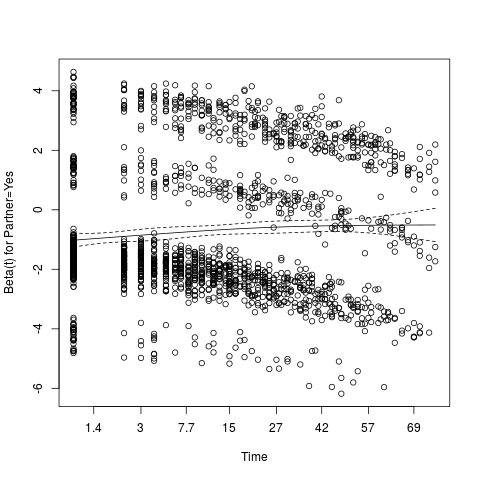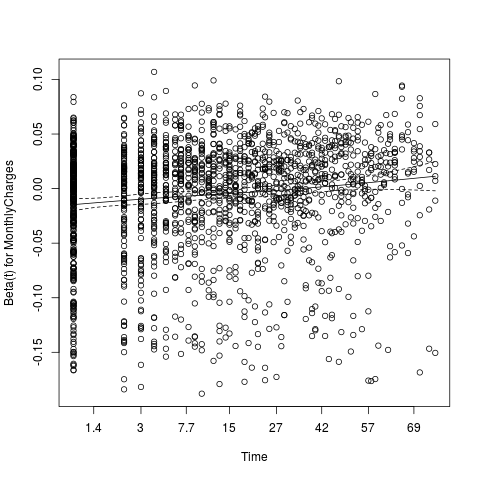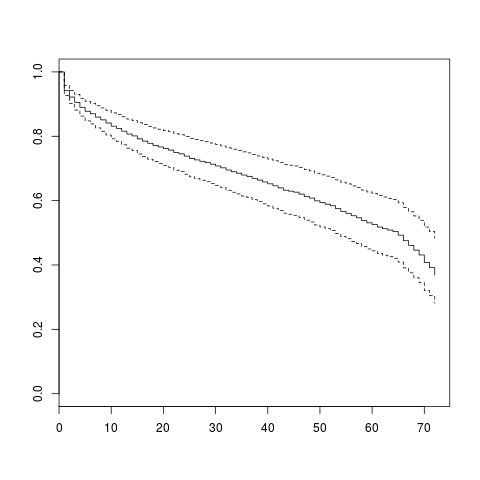Checking model assumptions and making predictions
Machine Learning for Marketing Analytics in R

Verena Pflieger
Data Scientist at INWT Statistics
Test of PH assumption
testCPH1 <- cox.zph(fitCPH1)
print(testCPH1)
rho chisq p
gender=Male 0.0317 1.884 1.70e-01
SeniorCitizen=Yes 0.0587 6.507 1.07e-02
Partner=Yes 0.0752 10.116 1.47e-03
Dependents=Yes 0.0131 0.314 5.75e-01
StreamMov=NoIntServ -0.0448 3.588 5.82e-02
StreamMov=Yes 0.0827 12.174 4.85e-04
PaperlessBilling=Yes 0.0180 0.611 4.34e-01
PayMeth=CreditCard(auto) 0.0253 1.198 2.74e-01
PayMeth=ElektCheck -0.0427 3.427 6.41e-02
PayMeth=MailedCheck -0.0851 13.069 3.00e-04
MonthlyCharges 0.1268 25.778 3.83e-07
GLOBAL NA 217.172 0.00e+00
Proportional hazards for Partner
plot(testCPH1, var = "Partner")

Proportional hazards for MonthlyCharges
plot(testCPH1, var = "MonthlyCharges")

General remarks on tests
cox.zph()-test conservative- Sensitive to number of observations
- Different gravity of violations
What if PH assumption is violated?
- Stratified analysis
fitCPH2 <- cph(Surv(tenure, churn) ~ MonthlyCharges +
SeniorCitizen + Partner + Dependents +
StreamMov + Contract,
stratum = "gender = Male",
data = dataSurv, x = TRUE, y = TRUE, surv = TRUE)
- Time-dependent coefficients
Validating the model
validate(fitCPH1,
method = "crossvalidation",
B = 10, pr = FALSE)
index.orig training test optimism index.corrected n
R2 0.2277 0.2279 0.2277 0.0002 0.2276 10
...
Probability not to churn at certain timepoint
oneNewData <- data.frame(gender = "Female",
SeniorCitizen = "Yes",
Partner = "No",
Dependents = "Yes",
StreamMov = "Yes",
PaperlessBilling = "Yes",
PayMeth = "BankTrans(auto)",
MonthlyCharges = 37.12)
str(survest(fitCPH1, newdata = oneNewData, times = 3))
List of 5
$ time : num 3
$ surv : num 0.905
$ std.err: num 0.0136
$ lower : num 0.881
$ upper : num 0.93
Survival curve for new customer
plot(survfit(fitCPH1, newdata = oneNewData))

Predicting expected time until churn
print(survfit(fitCPH1, newdata = oneNewData))
Call: survfit(formula = fitCPH1, newdata = oneNewData)
n events median 0.95LCL 0.95UCL
5311 1869 65 53 72
Learnings
| Learnings about survival analyis | |
|---|---|
| You have learned... | to visualize the tenure times of customers |
| to model the time to an event and extract factors influencing it | |
| how to validate the model | |
| how to make predictions |
| Learnings from the model | |
|---|---|
| You have learned... | that being senior citizen increases the probability to churn by 23% |
| that a one-unit increase in monthly charges decreases the hazard of churning by about 1% |
It is up to you now!
Machine Learning for Marketing Analytics in R

